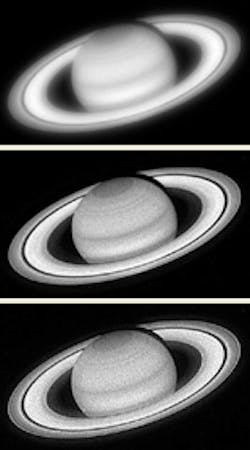
A degraded optical image can be at least partially restored by mathematically removing the effects of the optical system. Such an operation, called a deconvolution, is done most easily if the imaging quality of the optical system—in the form of a point-spread function (PSF)—is known. Because the PSF of an optical system is often hard to obtain, so-called blind deconvolution techniques have been developed that base their calculations solely on the degraded image itself. Such techniques, however, usually require iterative calculations that greatly boost the amount of computation required. Researchers at Research Support Instruments (Lanham, MD), the Naval Research Laboratory, and the Catholic University of America (both of Washington, DC) have developed a blind deconvolution technique that requires no iteration and is simple to execute.1
In general, degraded data is represented by the convolution of the perfect optical image with the PSF, with a noise term added. In frequency space (in other words, when a Fourier transform is done), the convolution becomes a multiplication and the PSF a transfer function. To prepare the data, the researchers remove the phase information and apply a smoothing function. The effect of the transfer function is replaced by raising the Fourier transform of the degraded data to the power alpha (a) and multiplying by a constant. Exactness would require a to be frequency-dependent, but, as researcher Jim Caron says, "The surprising thing is that, for many images and data, a frequency-independent a makes a good approximation."
The algorithm factors in noise from the start so that it does not hinder the process at all, notes Caron. Once a is determined for a specific system, it can be used for all additional data taken with that system. In one example, an image taken from the Hubble Space Telescope before its optical correction in 1993 is processed. The uncorrected image (top) is contrasted with an image derived by blind deconvolution (center). The derived image is seen to be equivalent in quality to one resulting from deconvolution with the known, measured PSF (bottom).
REFERENCE
- J. N. Caron et. al., Opt. Lett. 26 (15) 1164 (Aug. 1, 2001).

John Wallace | Senior Technical Editor (1998-2022)
John Wallace was with Laser Focus World for nearly 25 years, retiring in late June 2022. He obtained a bachelor's degree in mechanical engineering and physics at Rutgers University and a master's in optical engineering at the University of Rochester. Before becoming an editor, John worked as an engineer at RCA, Exxon, Eastman Kodak, and GCA Corporation.